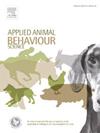Review of depressive-like behaviours in some group-living mammals
IF 2
2区 农林科学
Q1 AGRICULTURE, DAIRY & ANIMAL SCIENCE
引用次数: 0
Abstract
Thanks to animal models of depression, we are getting closer to understand the nature of this disorder in humans – but depressive disorders may not be specific only to humans. Although due to the inability to collect a verbal report from animals and the lack of direct insight into their mental states, the diagnosis of depression in animals is based on behavioural observations, which is considered insufficient to diagnose the disorder. Nevertheless, animal models of depression indicate the possibility of depression-like states in laboratory animals. This review aims to bring together previous reports of depressive disorder symptoms in group-living mammalian species living in unnatural environments and/or experiencing relatively frequent contact with humans: primates, marine mammals, domestic horses and elephants. The paper summarizes previous reports of depressive-like symptoms in those species, pointing out the similarity of depression-like symptoms in aforementioned animals to those observable in human depression. The efficacy of pharmacological treatments indicates that the brain biochemistry of depressive-like states is similar in both laboratory animals and humans. Those symptoms in laboratory animals are similar to certain species of group-living mammalian species – furthermore, the methods for inducing similar states are not uncommon in the training of the aforementioned mammals, indicating similar causes of the phenomenon. All previous reports of Major Depressive Disorder symptoms listed in the DSM-V and noticed in animals were considered and redescribed, such as: loss of interest (anhedonia), sleep disorders, psychomotor retardation, fatigue, feeling worthless, decreased concentration, self-harm and impairment in social. In addition, behavioural changes similar to mourning states resulting from changes in herd structure and stereotypies occurring in captive animals were taken into account. The data collected shows that, based on observed behaviours and similarities to symptoms in laboratory animals, at least some of group-living mammalian species experiencing relatively frequent contact with humans may suffer from depression-like symptoms, which may not only extend the knowledge of depression in humans, but also have a significant impact on improving the welfare of captive animals. Perhaps the only difference found between humans and some animals when it comes to depressive disorder is the ability to verbally report one's internal states.
一些群居哺乳动物的类抑郁行为综述
由于有了抑郁症的动物模型,我们越来越了解这种疾病在人类中的本质——但抑郁症可能不仅仅局限于人类。虽然由于无法收集动物的口头报告和缺乏对其精神状态的直接洞察,但对动物抑郁症的诊断是基于行为观察,这被认为不足以诊断这种疾病。然而,抑郁症的动物模型表明,在实验动物中可能出现类似抑郁症的状态。这篇综述的目的是汇集以往关于生活在非自然环境和/或与人类有相对频繁接触的群居哺乳动物的抑郁障碍症状的报道:灵长类动物、海洋哺乳动物、驯养的马和大象。本文总结了这些物种中类似抑郁症状的先前报道,指出上述动物的类似抑郁症状与人类抑郁症的相似之处。药物治疗的效果表明,实验动物和人类抑郁样状态的脑生化是相似的。实验动物的这些症状与群居哺乳动物的某些物种相似——此外,在上述哺乳动物的训练中,诱导类似状态的方法并不罕见,这表明造成这种现象的原因相似。所有先前在DSM-V中列出并在动物中注意到的重度抑郁症症状的报告都被考虑并重新描述,例如:失去兴趣(快感缺乏)、睡眠障碍、精神运动迟缓、疲劳、感觉毫无价值、注意力下降、自我伤害和社交障碍。此外,还考虑到圈养动物中由于兽群结构和刻板印象的变化而引起的类似于哀悼状态的行为变化。收集的数据表明,根据观察到的行为以及与实验动物症状的相似性,至少有一些与人类接触相对频繁的群居哺乳动物物种可能患有类似抑郁症的症状,这不仅可能扩展人类对抑郁症的认识,而且对改善圈养动物的福利也有重大影响。当谈到抑郁症时,人类和一些动物之间的唯一区别可能是口头报告自己内部状态的能力。
本文章由计算机程序翻译,如有差异,请以英文原文为准。
求助全文
约1分钟内获得全文
求助全文
来源期刊

Applied Animal Behaviour Science
农林科学-行为科学
CiteScore
4.40
自引率
21.70%
发文量
191
审稿时长
18.1 weeks
期刊介绍:
This journal publishes relevant information on the behaviour of domesticated and utilized animals.
Topics covered include:
-Behaviour of farm, zoo and laboratory animals in relation to animal management and welfare
-Behaviour of companion animals in relation to behavioural problems, for example, in relation to the training of dogs for different purposes, in relation to behavioural problems
-Studies of the behaviour of wild animals when these studies are relevant from an applied perspective, for example in relation to wildlife management, pest management or nature conservation
-Methodological studies within relevant fields
The principal subjects are farm, companion and laboratory animals, including, of course, poultry. The journal also deals with the following animal subjects:
-Those involved in any farming system, e.g. deer, rabbits and fur-bearing animals
-Those in ANY form of confinement, e.g. zoos, safari parks and other forms of display
-Feral animals, and any animal species which impinge on farming operations, e.g. as causes of loss or damage
-Species used for hunting, recreation etc. may also be considered as acceptable subjects in some instances
-Laboratory animals, if the material relates to their behavioural requirements
 求助内容:
求助内容: 应助结果提醒方式:
应助结果提醒方式:


